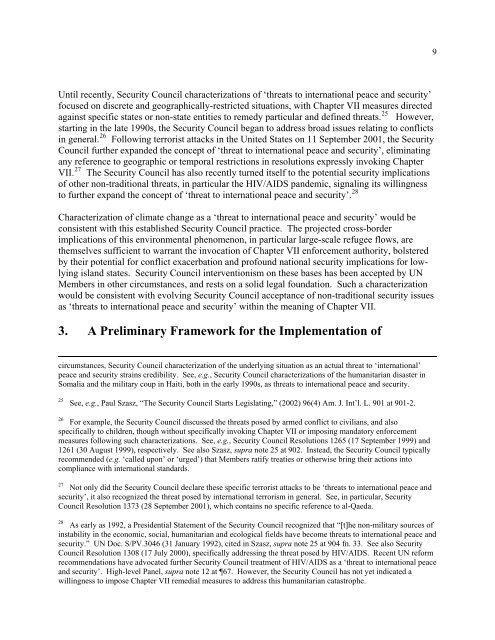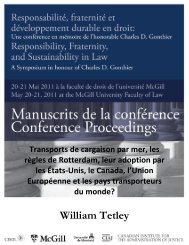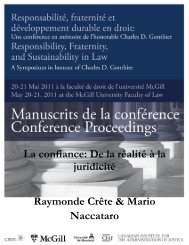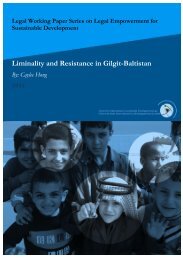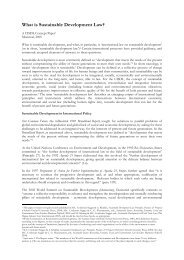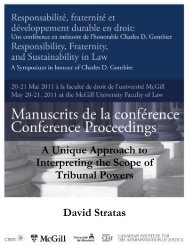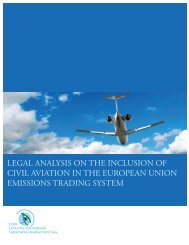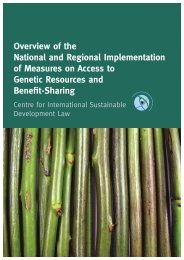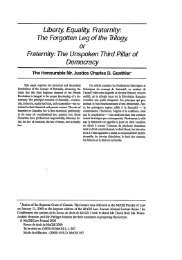Climate Change and the Security Council - CISDL
Climate Change and the Security Council - CISDL
Climate Change and the Security Council - CISDL
Create successful ePaper yourself
Turn your PDF publications into a flip-book with our unique Google optimized e-Paper software.
9<br />
Until recently, <strong>Security</strong> <strong>Council</strong> characterizations of ‘threats to international peace <strong>and</strong> security’<br />
focused on discrete <strong>and</strong> geographically-restricted situations, with Chapter VII measures directed<br />
against specific states or non-state entities to remedy particular <strong>and</strong> defined threats. 25 However,<br />
starting in <strong>the</strong> late 1990s, <strong>the</strong> <strong>Security</strong> <strong>Council</strong> began to address broad issues relating to conflicts<br />
in general. 26 Following terrorist attacks in <strong>the</strong> United States on 11 September 2001, <strong>the</strong> <strong>Security</strong><br />
<strong>Council</strong> fur<strong>the</strong>r exp<strong>and</strong>ed <strong>the</strong> concept of ‘threat to international peace <strong>and</strong> security’, eliminating<br />
any reference to geographic or temporal restrictions in resolutions expressly invoking Chapter<br />
VII. 27 The <strong>Security</strong> <strong>Council</strong> has also recently turned itself to <strong>the</strong> potential security implications<br />
of o<strong>the</strong>r non-traditional threats, in particular <strong>the</strong> HIV/AIDS p<strong>and</strong>emic, signaling its willingness<br />
to fur<strong>the</strong>r exp<strong>and</strong> <strong>the</strong> concept of ‘threat to international peace <strong>and</strong> security’. 28<br />
Characterization of climate change as a ‘threat to international peace <strong>and</strong> security’ would be<br />
consistent with this established <strong>Security</strong> <strong>Council</strong> practice. The projected cross-border<br />
implications of this environmental phenomenon, in particular large-scale refugee flows, are<br />
<strong>the</strong>mselves sufficient to warrant <strong>the</strong> invocation of Chapter VII enforcement authority, bolstered<br />
by <strong>the</strong>ir potential for conflict exacerbation <strong>and</strong> profound national security implications for lowlying<br />
isl<strong>and</strong> states. <strong>Security</strong> <strong>Council</strong> interventionism on <strong>the</strong>se bases has been accepted by UN<br />
Members in o<strong>the</strong>r circumstances, <strong>and</strong> rests on a solid legal foundation. Such a characterization<br />
would be consistent with evolving <strong>Security</strong> <strong>Council</strong> acceptance of non-traditional security issues<br />
as ‘threats to international peace <strong>and</strong> security’ within <strong>the</strong> meaning of Chapter VII.<br />
3. A Preliminary Framework for <strong>the</strong> Implementation of<br />
circumstances, <strong>Security</strong> <strong>Council</strong> characterization of <strong>the</strong> underlying situation as an actual threat to ‘international’<br />
peace <strong>and</strong> security strains credibility. See, e.g., <strong>Security</strong> <strong>Council</strong> characterizations of <strong>the</strong> humanitarian disaster in<br />
Somalia <strong>and</strong> <strong>the</strong> military coup in Haiti, both in <strong>the</strong> early 1990s, as threats to international peace <strong>and</strong> security.<br />
25<br />
See, e.g., Paul Szasz, “The <strong>Security</strong> <strong>Council</strong> Starts Legislating,” (2002) 96(4) Am. J. Int’l. L. 901 at 901-2.<br />
26<br />
For example, <strong>the</strong> <strong>Security</strong> <strong>Council</strong> discussed <strong>the</strong> threats posed by armed conflict to civilians, <strong>and</strong> also<br />
specifically to children, though without specifically invoking Chapter VII or imposing m<strong>and</strong>atory enforcement<br />
measures following such characterizations. See, e.g., <strong>Security</strong> <strong>Council</strong> Resolutions 1265 (17 September 1999) <strong>and</strong><br />
1261 (30 August 1999), respectively. See also Szasz, supra note 25 at 902. Instead, <strong>the</strong> <strong>Security</strong> <strong>Council</strong> typically<br />
recommended (e.g. ‘called upon’ or ‘urged’) that Members ratify treaties or o<strong>the</strong>rwise bring <strong>the</strong>ir actions into<br />
compliance with international st<strong>and</strong>ards.<br />
27<br />
Not only did <strong>the</strong> <strong>Security</strong> <strong>Council</strong> declare <strong>the</strong>se specific terrorist attacks to be ‘threats to international peace <strong>and</strong><br />
security’, it also recognized <strong>the</strong> threat posed by international terrorism in general. See, in particular, <strong>Security</strong><br />
<strong>Council</strong> Resolution 1373 (28 September 2001), which contains no specific reference to al-Qaeda.<br />
28<br />
As early as 1992, a Presidential Statement of <strong>the</strong> <strong>Security</strong> <strong>Council</strong> recognized that “[t]he non-military sources of<br />
instability in <strong>the</strong> economic, social, humanitarian <strong>and</strong> ecological fields have become threats to international peace <strong>and</strong><br />
security.” UN Doc. S/PV.3046 (31 January 1992), cited in Szasz, supra note 25 at 904 fn. 33. See also <strong>Security</strong><br />
<strong>Council</strong> Resolution 1308 (17 July 2000), specifically addressing <strong>the</strong> threat posed by HIV/AIDS. Recent UN reform<br />
recommendations have advocated fur<strong>the</strong>r <strong>Security</strong> <strong>Council</strong> treatment of HIV/AIDS as a ‘threat to international peace<br />
<strong>and</strong> security’. High-level Panel, supra note 12 at 67. However, <strong>the</strong> <strong>Security</strong> <strong>Council</strong> has not yet indicated a<br />
willingness to impose Chapter VII remedial measures to address this humanitarian catastrophe.


